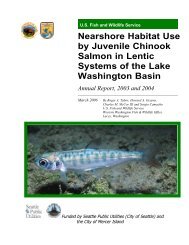2006 Water Comprehensive Plan - City of Bellevue
2006 Water Comprehensive Plan - City of Bellevue
2006 Water Comprehensive Plan - City of Bellevue
- No tags were found...
You also want an ePaper? Increase the reach of your titles
YUMPU automatically turns print PDFs into web optimized ePapers that Google loves.
Discussion:"Adverse financial performance" or "worst case" are defined by the 95% confidenceinterval based on historical patterns. The worst case year is currently defined as a yearwith sales volumes 15% below the sales volume for a normal year. This wasdetermined by using statistical measurements <strong>of</strong> sales volumes for 18 years with a 95%confidence interval. That is, in any given year there is only a 5% chance that the worstcase year would be more than 15% below the normal year. Another way to say thesame thing is that in 19 out <strong>of</strong> 20 years the worst case year would not be more than 15%below the normal year.Maintaining the 95% confidence interval, as more and more data becomes available, aworst case year could change upward or downward from the 15% variation from anormal year.The recommended reserve policies are premised on the vital expectation that reservesare to be used and reserve-levels will fluctuate. Although budget and rate planning areexpected to use the target reserve number, reserve levels planned to remain static areby definition unnecessary. It is therefore important to plan for managing the reserveswithin a working range between the minimum and target levels as stated in the abovepolicies. There may be situations in short-range financial planning where reserves aremaintained above target levels to overcome peaks in actual expenses.In the event <strong>of</strong> an inter-utility loan, the balance for the borrowing utility would essentiallybe any cash balance less the amount owed. The lending utility would count the note asa part <strong>of</strong> its reserves, so that it does not unnecessarily increase rates to replenishreserves that are loaned.In this management approach, there is still a risk that a major plant emergency couldexceed the amount reserved. Such a major shortfall would require rate action to assurea certain level <strong>of</strong> replenishment in one year. To avoid rate spikes due to this type <strong>of</strong>action, they should be considered on a case-by-case basis. This will provide theflexibility to use debt or capital reserves in lieu <strong>of</strong> operating reserves to cover the costand allow a moderated approach to replenishing reserves out <strong>of</strong> rates.C. Asset Replacement ReservesUtility funds will maintain separate Asset Replacement Accounts to provide asource <strong>of</strong> funding for future replacement <strong>of</strong> operating equipment and systems.Anticipated replacement costs by year for the upcoming 20-year period, for allUtility asset and equipment items, will be developed as a part <strong>of</strong> each biennialbudget preparation process. Budgeted contribution to the Asset ReplacementAccount will be based on the annual amount needed to maintain a positive cashflow balance in the Asset Replacement Account over the 20-year forecast period.At a minimum, the ending Asset Replacement Account balance in each Utility willequal, on average, the next year’s projected replacement costs for that fund.The Utilities Department will observe adopted Equipment Rental Fund (ERF) andInformation Services budget policies and procedures in formulatingrecommendations regarding specific equipment items to be replaced.2-37
















